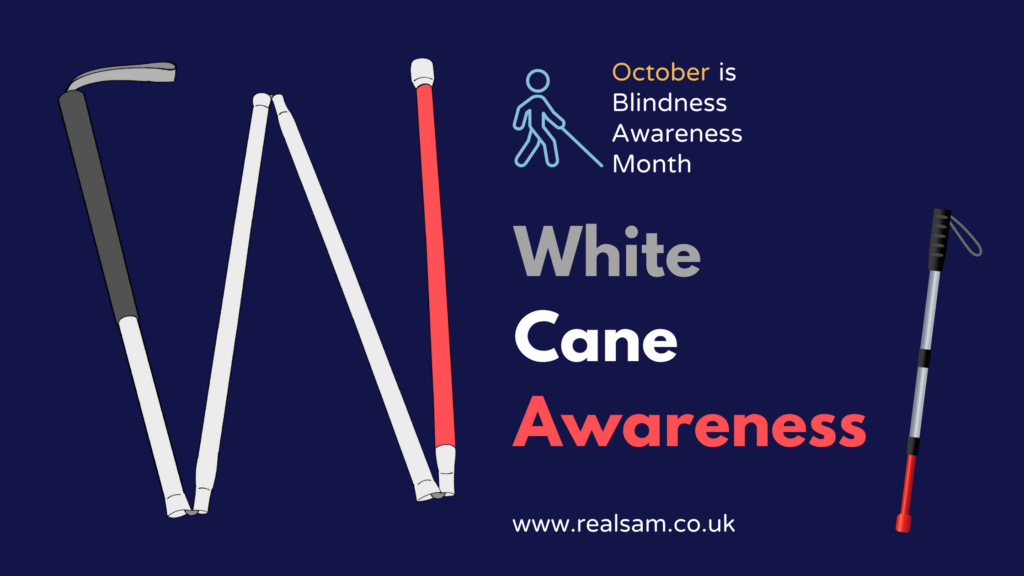Throughout history, the cane or the staff has been used by travellers. But for those who are blind or visually impaired, the white cane has become a symbol of independence.
Here are 15 interesting facts you can enjoy and share in light of Blindness Awareness Month and White Cane Awareness Day:
- The white cane is an indispensable mobility tool for someone who is blind or visually impaired. It’s used to detect obstacles like signs and barriers, steps going up or down and the terrain, grass, footpaths, etc.
- You don’t need to be totally blind to use a white cane. If as a partially sighted person you can gain more confidence with a tool that will give you information, use a cane. Some people only need to use their cane in unfamiliar places. Others use their cane depending on the time of day and how well they can see in different lighting conditions. Still other people use their cane every time they’re going out.
- The white cane is recognised internationally. It lets people know that the person using it is visually impaired. Over the years, it has also become a symbol of independence, a statement to society that blind persons are capable of navigating their environment and doing many other things independently.
- In the UK, someone using a white cane is recognised as visually impaired while white canes with red bands stand for blind individuals who are also hearing impaired.
- Not every blind person uses a white cane. Some depend on sighted guides, guide dogs, and their usable vision.
- Symbol canes or ID canes are shorter and lighter versions of the standard guide or long canes. They are helpful for partially sighted people who have low vision but can see well enough to manage without using their cane for a guide. In a busy area, this is helpful for motorists and other pedestrians to be aware that they are approaching someone who may need assistance or might not be able to see them or something around them.
- There are different ways to use the white cane. With the two-point-touch method, the user holds the cane diagonally straight out in front of them and taps to the left then to the right as they walk forward. Using the constant contact technique, the user would hold the cane the same way and sweeps it left and right, never letting the tip off the ground. You can use your cane to stay on one side of a path by letting it detect one edge as you walk. How someone uses their cane may depend on where they are or their preference and comfort in any given situation. During orientation and mobility instructions (O&M) blind and visually impaired people get training to navigate with their cane and learn routes to places they normally need to go to.
- White canes are usually made with aluminum, fiberglass, or carbon fiber. On one end they have a handle wrapped with rubber and may include a wrist loop. On the other end the white cane will have a unique tip that will help the user feel the texture of what they will be stepping on.
- There are various cane tips to choose from, some roll and some are static. There are pencil tips, mushroom/marshmallow shaped tips, ball tips, wheel tips, and more. Tips can be replaced using the same cane. Customisation helps the user feel comfortable and use their cane efficiently in different situations. For example, using a large rolling ball tip when you’re walking on rugged terrains versus using a lightweight pencil tip when you’re tapping side to side on busy footpaths.
- The recommended length of the cane that someone uses will depend on their height. Usually, guide canes reach chest height.
- James Biggs from Bristol is the first visually impaired person known to use a white cane. He was an artist who lost his sight due to an accident. In 1921, he painted his walking stick white so that he could be visible to drivers and pedestrians as he walked around the area by his home.
- In 1931 a national white stick movement took place in France and lead to a campaign that spread throughout the UK with the support of charities and rotary clubs.
- In North America, the Lions Club International was the organisation that promoted the use of white canes. One of their members witnessed a blind person attempt to cross a busy road with a black cane that was barely visible. This sparked a movement throughout the United States for white canes to be issued as identifiers. The first White Cane Ordinance was passed in Peoria Illinois, granting visually impaired pedestrians protection and right of way when carrying a white cane.
- Many veterans from WWI and WWII suffered from injuries and sight loss. Originally, the white cane was just a white version of the average walking cane. But with an influx of veterans needing rehabilitation and independence in society, rehabilitation specialist Dr. Richard E. Hoover pioneered the use of long canes that would be swept from side to side, allowing the user to navigate more efficiently and use the cane to get more information.
- US President Lyndon B. Johnson was the first to proclaim October 15th as White Cane Safety Day. Today it’s recogonised annually in multiple nations around the world as White Cane Awareness Day.
Hopefully you enjoyed these facts and can share them to raise awareness. And if you’re sighted, remember, if you see someone holding the white cane, they may not see you, so be sure to wait for them to cross before you go.
Read more on being out and about and RealSAM features that help with navigation from the RealSAM News Page.
RealSAM Navigation Tool – Get Accurate Location and nearby Points of Interests
RealSAM Navigation Tool – Outdoor Locations
By Guenivir Kendrick
Reference:
RNIB (2023). Making Our Streets inclusive for Everyone. Available at:
(Accessed: 30 October 2023).
Strong P. History of the White Cane. Available at:
https://www.njcounciloftheblind.org/brochures/history_of_white_cane.htm
(Accessed: 30 October 2023).




